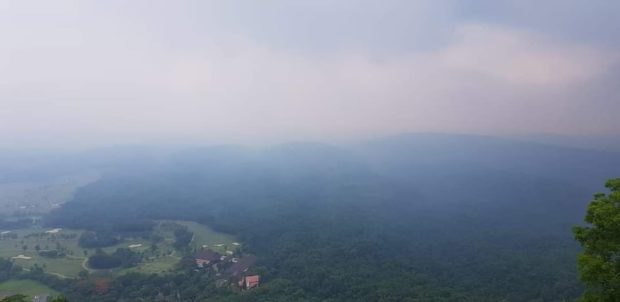Vog caused by Taal Volcano troubles Batangas town

SMOG-COVERED TOWN Thick volcanic smog, or “vog,” from Taal Volcano covers Talisay town on Friday in this photo taken from Tagaytay City. —PHOTO COURTESY OF THE TALISAY MUNICIPAL DISASTER RISK REDUCTION MANAGEMENT OFFICE
LUCENA CITY, Quezon, Philippines — Life for residents in Talisay town in Batangas province has been slowly returning to its normal daily routine except on days when smog from the still restive Taal Volcano invades the locality.
“Life is almost back to normal again,” Peter John Mirania, Talisay Municipal Disaster Risk Reduction and Management official, said in a phone interview on Saturday.
Mirania said the locals were no longer panicking every time Taal trembled but were more disturbed by the volcanic smog, or vog, resulting from the continued volcanic sulfur dioxide (SO2) gas emission from the volcano.
Mirania said the locality was again engulfed in smog on Friday.
“Almost entire Talisay was enveloped in smog. It started around 5 a.m. and lasted until after lunch. It rained so it went away,” he said.
Article continues after this advertisementHealth authorities reminded the residents to wear N95 face masks when going out of the house for protection against SO2 plumes from the volcano.
Article continues after this advertisementVog is a type of air pollution that is caused by volcanoes. It consists of fine droplets containing volcanic gas, which is acidic. It causes irritation to the eyes, throat and is a health threat to persons with respiratory illness.
Mirania said the occasional tremors from the volcano no longer alarmed the residents.
Stay alert
But he quickly added that the local government has been reminding the townspeople to remain vigilant and be mindful of their safety.
Mirania stressed that no one should be complacent amid the continued threat from the volcano, which sits in the middle of Taal Lake.
Talisay is one of the localities that surround Taal Lake, along with the towns of Laurel, Agoncillo, Sta. Teresita, San Nicolas, Alitagtag, Cuenca, Balete and Mataasnakahoy, and the cities of Tanauan and Lipa, all in Batangas province.
The Philippine Institute of Volcanology and Seismology (Phivolcs) reported on Sunday that 86 volcanic earthquakes, including 84 tremor events lasting from a minute to 34 minutes, were recorded over a 24-hour observation period.
“High levels of volcanic sulfur dioxide or SO2 gas emissions and steam-rich plumes that rose 2,100 meters before drifting northeast was generated from the Taal main crater,” it said.
Phivolcs said Taal’s SO2 emission averaged 6,574 metric tons on Friday but dropped to 5,466 MT on Saturday.
The volcano remained under alert level 3, which was hoisted since Taal’s mild eruption on July 1. Alert level 3 indicates “high level of volcanic unrest,” with magma near or at the volcano’s surface and volcanic activity possibly leading to “hazardous eruption.”
Talisay residents are still not required to evacuate but the municipal government is ready to move them to safer areas if it becomes necessary, Mirania said.
But 873 individuals from 233 families who fled from Taal’s eruption in January last year are still sheltered in three evacuation centers in the town. Around 100 of them have received the first dose of Sinovac and AstraZeneca vaccines against COVID-19, Mirania said.
The town still has 19 active COVID-19 cases but no one from among the evacuees, he said.